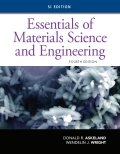
Interpretation:
The cost of material per unit volume is more important in some cases than the cost per unit weight. The cost needs to be determined in terms of
Concept Introduction:
Specific strength can be calculated as follows:
It relates the specific strengths of steel, few high strength non-ferrous alloys, and polymer- matrix composites. Additional factor to study in designing with non-ferrous material is their rate, which also differs significantly.
Explanation of Solution
Table no.1
| Metal | Density(g/ | Cost per kg($/kg) | Rank |
| Steels | 7.87 | 0.22 | 1 |
| Zinc | 7.13 | 0.88 | 2 |
| Lead | 11.36 | 0.99 | 3 |
| Aluminium | 2.70 | 1.32 | 4 |
| Copper | 8.93 | 1.57 | 5 |
| Magnesium | 1.74 | 3.31 | 6 |
| Titanium | 4.51 | 8.82 | 7 |
| Tungsten | 19.25 | 8.82 | 8 |
| Nickel | 8.90 | 9.04 | 9 |
| Beryllium | 1.85 | 777.60 | 10 |
The cost of a material per unit volume can be converted from ($/kg) to ($/g) by dividing the cost of material by 1000, and multiplying the converted cost value with density.
Table no. 2
| Metal | Density | Cost per kg | Cost per gram | Cost per volume | Rank |
| Steel | 7.87 | 0.22 | 0.22 | 0.0017 | 1 |
| Aluminium | 2.70 | 1.32 | 1.32 | 0.0036 | 2 |
| Magnesium | 1.74 | 3.31 | 3.31 | 0.0057 | 3 |
| Zinc | 7.13 | 0.88 | 0.88 | 0.0063 | 4 |
| Lead | 11.36 | 0.99 | 0.99 | 0.0013 | 5 |
| Copper | 8.93 | 1.57 | 1.57 | 0.0140 | 6 |
| Titanium | 4.51 | 8.82 | 8.82 | 0.0397 | 7 |
| Nickel | 8.90 | 9.04 | 9.04 | 0.0804 | 8 |
| Tungsten | 19.25 | 8.82 | 8.82 | 0.1696 | 9 |
| Beryllium | 1.85 | 771.60 | 771.60 | 1.4247 | 10 |
From the above two tables, the different materials are related to each other in terms of cost per kilogram and cost per volume.
Want to see more full solutions like this?
Chapter 14 Solutions
Essentials of Materials Science and Engineering, SI Edition
- my ID# 016948724. Please solve this problem step by steparrow_forwardPlease solve the following question in the picture, make sure you show all of your work and formulas you use. Thank you so much for your help!arrow_forwardMy ID# 016948724 please find the forces for Fx=0: fy=0: fz=0: please help me to solve this problem step by steparrow_forward
- My ID# 016948724 please solve the proble step by step find the forces fx=o: fy=0; fz=0; and find shear moment and the bending moment diagran please draw the diagram for the shear and bending momentarrow_forwardMy ID#016948724. Please help me to find the moment of inertia lx ly are a please show to solve step by stepsarrow_forwardplease solve this problem step by steparrow_forward
 MATLAB: An Introduction with ApplicationsEngineeringISBN:9781119256830Author:Amos GilatPublisher:John Wiley & Sons Inc
MATLAB: An Introduction with ApplicationsEngineeringISBN:9781119256830Author:Amos GilatPublisher:John Wiley & Sons Inc Essentials Of Materials Science And EngineeringEngineeringISBN:9781337385497Author:WRIGHT, Wendelin J.Publisher:Cengage,
Essentials Of Materials Science And EngineeringEngineeringISBN:9781337385497Author:WRIGHT, Wendelin J.Publisher:Cengage, Industrial Motor ControlEngineeringISBN:9781133691808Author:Stephen HermanPublisher:Cengage Learning
Industrial Motor ControlEngineeringISBN:9781133691808Author:Stephen HermanPublisher:Cengage Learning Basics Of Engineering EconomyEngineeringISBN:9780073376356Author:Leland Blank, Anthony TarquinPublisher:MCGRAW-HILL HIGHER EDUCATION
Basics Of Engineering EconomyEngineeringISBN:9780073376356Author:Leland Blank, Anthony TarquinPublisher:MCGRAW-HILL HIGHER EDUCATION Structural Steel Design (6th Edition)EngineeringISBN:9780134589657Author:Jack C. McCormac, Stephen F. CsernakPublisher:PEARSON
Structural Steel Design (6th Edition)EngineeringISBN:9780134589657Author:Jack C. McCormac, Stephen F. CsernakPublisher:PEARSON Fundamentals of Materials Science and Engineering...EngineeringISBN:9781119175483Author:William D. Callister Jr., David G. RethwischPublisher:WILEY
Fundamentals of Materials Science and Engineering...EngineeringISBN:9781119175483Author:William D. Callister Jr., David G. RethwischPublisher:WILEY





